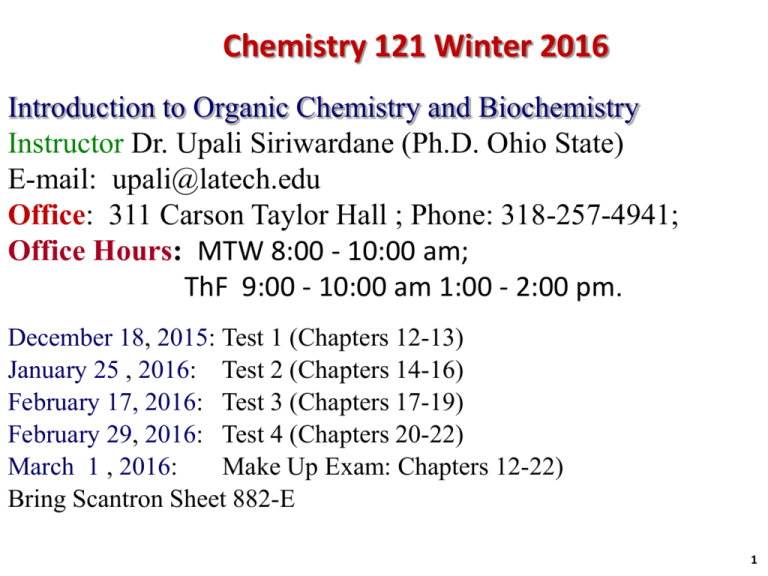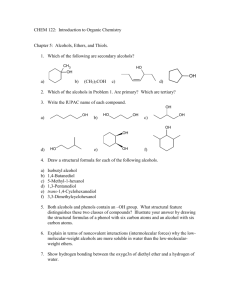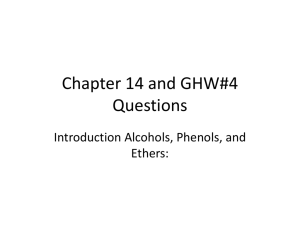GHW%234-Questions&slides
advertisement

Chemistry 121 Winter 2016 Introduction to Organic Chemistry and Biochemistry Instructor Dr. Upali Siriwardane (Ph.D. Ohio State) E-mail: upali@latech.edu Office: 311 Carson Taylor Hall ; Phone: 318-257-4941; Office Hours: MTW 8:00 - 10:00 am; ThF 9:00 - 10:00 am 1:00 - 2:00 pm. December 18, 2015: Test 1 (Chapters 12-13) January 25 , 2016: Test 2 (Chapters 14-16) February 17, 2016: Test 3 (Chapters 17-19) February 29, 2016: Test 4 (Chapters 20-22) March 1 , 2016: Make Up Exam: Chapters 12-22) Bring Scantron Sheet 882-E 1 Chapter 14 and GHW#4 Questions Introduction Alcohols, Phenols, and Ethers: Chapter 14. Alcohols, Phenols, and Ethers 14.1 Bonding Characteristics of Oxygen Atoms in Organic Compounds, 423 14.2 Structural Characteristics of Alcohols, 424 14.3 Nomenclature for Alcohols, 425 14.4 Isomerism for Alcohols, 427 14.5 Important Commonly Encountered Alcohols, 427 14.6 Physical Properties of Alcohols, 431 14.7 Preparation of Alcohols, 433 14.8 Classification of Alcohols, 434 14.9 Chemical Reactions of Alcohols, 435 14.10 Polymeric Alcohols, 443 14.11 Structural Characteristics of Phenols, 443 14.12 Nomenclature for Phenols, 443 14.13 Physical and Chemical Properties of Phenols, 444 14.14 Occurrence of and Uses for Phenols, 445 14.15 Structural Characteristics of Ethers, 447 14.16 Nomenclature for Ethers, 449 14.17 Isomerism for Ethers, 452 14.18 Physical and Chemical Properties of Ethers, 453 14.19 Cyclic Ethers, 454 14.20 Sulfur Analogs of Alcohols, 454 14.21 Sulfur Analogs of Ethers, 457 Alcohols, Phenols, and Ethers • • • • • Functional groups: alcohol: R-O-H phenols: Ar-OH ether: R-O-R' thiol: R-S-H Alkyl, R = CH3 Mehtyl etc. Phenyl, Ar = C6H5 1. Bonding Characteristics of Oxygen Atoms in Organic Compounds Structural Characteristics of Alcohols Alcohols - Nomenclature • IUPAC names – the parent chain is the longest chain that contains the -OH group – number the parent chain in the direction that gives the -OH group the lower number – change the suffix -e to -ol • Common names – name the alkyl group bonded to oxygen followed by the word alcohol Nomenclature of compounds containing functional groups • The IUPAC system deals with functional groups two different ways. • Modification of the hydrocarbon name to indicate the presence of a functional group. • alcohol, -OH use -ol ending. • ether: CH3CH2-O-CH3 use methoxy methoxy ethane • thiol: R-S-H use -thiol ending. Alcohols - Nomenclature Problem: Write the IUPAC name of each alcohol (a) CH3 ( CH2 ) 6 CH2 OH OH (b) OH (c) Alcohols - Nomenclature Compounds containing – two -OH groups are named as diols, – three -OH groups are named as triols, etc. CH2 CH2 OH OH 1,2-Eth anediol (Eth ylen e glycol) CH3 CHCH2 HO OH 1,2-Propan ediol (Propylene glycol) CH2 CHCH2 HO HO OH 1,2,3-Propan etriol (Glycerol, Glycerin) Alcohols - Nomenclature Examples: OH Eth anol (Ethyl alcoh ol) OH OH 1-Propan ol (Propyl alcohol) 2-Prop anol (Is op ropyl alcohol) OH OH 1-Butanol (Butyl alcohol) OH 2-Bu tan ol (s ec-Bu tyl alcohol) OH 2-Methyl-1-propanol (Is ob utyl alcoh ol) OH Cyclohexanol 2-Methyl-2-prop anol (t ert-Butyl alcohol) (Cyclohexyl alcohol) 1. Identify the Alcohols, Phenols, and Ethers from the following and give their common and/or IUPAC names. 1. Identify the Alcohols, Phenols, and Ethers from the following and give their common and/or IUPAC names. 2. Circle the constitutional isomers of 1- hexanol among following alcohols. Classification of alcohols • Primary • Secondary • Tertiary. 3. Classify each of the following as 1', 2', or 3' alcohols. a) d) b) c) Physical Properties of Alcohols • Alcohols are polar compounds – both the C-O and O-H bonds are polar covalent H + C H H O + H Hydrogen Bonding • Alcohols associate in the liquid state by hydrogen bonding • Hydrogen bonding: the attractive force between a partial positive charge on hydrogen and a partial negative charge on a nearby oxygen, nitrogen, or fluorine atom – the strength of hydrogen bonding in alcohols is approximately 2 to 5 kcal/mol – hydrogen bonds are considerably weaker than covalent bonds (for example, 110 kcal/mol for an O-H bond) – nonetheless, hydrogen bonding can have a significant effect on physical properties Hydrogen Bonding – Figure shows the association of ethanol molecules in the liquid state (only two of the three possible hydrogen bonds to the upper oxygen are shown here). Boiling Points – alcohols have higher boiling points and are more soluble in water than hydrocarbons Molecu lar Boilin g Weight Poin t Solub ility (g/mol) (°C) in Water Structural Formu la N ame CH3 OH CH3 CH3 methanol ethan e 32 30 65 -89 infinite ins olu ble CH3 CH2 OH CH3 CH2 CH3 ethan ol propane 46 44 78 -42 infinite ins olu ble CH3 CH2 CH2 OH CH3 CH2 CH2 CH3 1-propanol bu tane 60 58 97 0 infinite ins olu ble CH3 CH2 CH2 CH2 CH2 OH 1-pen tanol 88 138 2.3 g/100 g HOCH2 CH2 CH2 CH2 OH 1,4-bu tanediol CH3 CH2 CH2 CH2 CH2 CH3 hexan e 90 86 230 69 infinite ins olu ble Chemical Reactions of Alcohols 1) Combustion: Alcohol are very flammable and the combustion products are carbon dioxide and water. 2) Substitution Reactions: OH group is replaced by a another group such as halogen. 3) Elimination Reactions: Intarmolecular dehydration : Water is removed from a alcohol molecule and a alkene is produced. ( H2SO4 at 180) Intermolecular dehydration : Water is removed from two alcohol molecules and an ether is produced. ( H2SO4 at 140) Williamson Ether synthesis. 4) Oxidation Reactions: Oxygen is added to 1ry and 2ry alcohols Dehydration of Alcohols An alcohol can be converted to an alkene by elimination of H and OH from adjacent carbons (a -elimination) – 1° alcohols must be heated at high temperature in the presence of an acid catalyst, such as H2SO4 with K2CrO4 – 2° alcohols undergo dehydration at somewhat lower temperatures – 3° alcohols often require temperatures only at or slightly above room temperature Zaitsev’s rule (or the opposite of Markovnikov’s rule) Dehydration of an alcohol can result in more than one alkene product, because hydrogen loss can occur from either of the neighboring carbon atoms. Hydrogen is removed from the carbon with lowest hydrogen atoms ( poor get poorer) Dehydration of Alcohols – examples: CH3 CH 2 OH OH H2 SO 4 o 180 C CH 2 =CH 2 + H 2 O H2 SO 4 + H 2O 140o C Cyclohexanol CH3 CH3 COH CH3 Cyclohexene H2 SO 4 50o C CH3 CH3 C= CH2 + 2-Methylpropene (Is obutylene) H2 O 4a. Complete the following reactions of alcohol. a) Dehydration: 4b) What is Zaitsev Rule? 5) Complete the following reactions of alcohol oxidation: (Cr+6) (Cr+4) Green 6) Draw condensed formula of each of the following: a. 3-Hexanol b. 1,2,3-Pentanetriol c. 2-Methyl-2-pentanol d. Cyclohexanol e. 3,4-dimethyl-3-heptanol 7) Draw the alkene products of the dehydration of the following alcohols: a)2-Pentanol: b)3-Methyl-1-pentanol: c) 2-Butanol: d)4-Chloro-2-pentanol: e)1-Propanol: Oxidation of Alcohols • Oxidation of a 1° alcohol gives an aldehyde or a carboxylic acid, depending on the oxidizing agent and experimental conditions – the most common oxidizing agent is chromic acid CrO3 + H2 O Chromium(VI) oxide H2 SO4 H2 CrO4 Chromic acid – chromic acid oxidation of 1-octanol gives octanoic acid O O CrO3 CH3 (CH2 ) 6 CH2 OH CH3 (CH2 ) 6 CH H2 SO4 , H2 O 1-Octan ol Octan al (not isolated) CH3 (CH2 ) 6 COH Octan oic acid Oxidation of Alcohols – to oxidize a 1° alcohol to an aldehyde, use PCC CrO3 Cl- CrO3 + HCl + N Pyridine N+ H Pyridiniu m chloroch romate (PCC) – PCC oxidation of geraniol gives geranial O Geraniol PCC OH CH Cl 2 2 H Geranial • Tertiary alcohols are not oxidized by either of these reagents; they are resistant to oxidation 8) Give the oxidation products of the following alcohols. If no reaction occurs, write N.R.





